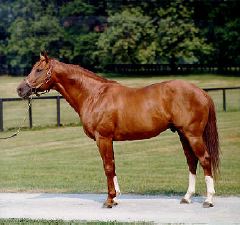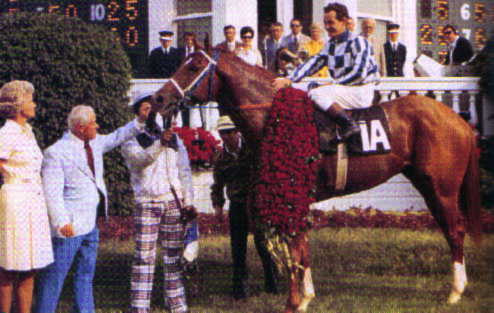

Secretariat. The name itself evokes a strength and passion in its own form; it is one that brings forth strong emotions and feelings of triumph, greatness, and awe. To those who once knew him, there could be no other horse in history that will ever match or take his place. Secretariat was an American original, a grand champion, and a superstar - the hero of his time. Forgetting who he was diminishes American society and takes away a wonderful piece from our hearts. Knowing his story can only inspire us all.
Unlike many story-book beginnings, Secretariat was not brought up in a poor area with misfortune hanging over his head. He was born into riches, and a little bit of luck. Under an arrangement between Ogden Phipps, owner of Claiborne Farm, and Helen "Penny" Tweedy, owner of the Meadow Stable, the Meadow would send two mares to Claiborne Farm to be bred to Bold Ruler, with each stable getting one foal apiece every year. The two stables had a coin toss every two years to determine who would have first choice that year, with the loser getting first choice the next year. The coin toss took place in 1969, with Claiborne Farm winning and taking a Bold Ruler--Somethingroyal filly named The Bride, who would fail to place in all six of her career starts. The next year, Meadow Stable got her full brother, Secretariat. The foal had come from unlikely bloodlines. Bold Ruler was known for speed, but not for long-distance races; Somethingroyal's lines were mostly noted for their stamina in classic stretch races. The combination of the two could have went for better or for worse. It was on March 30, 1970, at 12:10 in the morning when Somethingroyal dropped her foal at the Meadow. He was perfect from the moment he was born - bright- eyed, barrel-chested, legs flawlessly trim and tight, and with three socks and a star that ran into a stripe down his face. When Penny visited him for the first time with her notebook in which she keeps records of her horses, she made a one-word entry: "Wow." That became Penny's nickname for the big foal - he was her Wow Horse. When it came to naming the foal, six names were submitted to the Jockey Club for consideration. The club rejected Scepter, Royal Line, Something Special, Games of Chance, and Deo Volente, which is Latin for "God Willing," until finally accepting the name Secretariat for his registration.
The colt started training under Lucien Laurin, who thought Secretariat was too good-looking to be a good racehorse. However, with his heavy appetite, Secretariat became a little on the chubby side, resulting in having to patiently exercise the fat away, in addition to the normal workouts. With time, the colt began to improve, and Laurin began to see a difference in the horse's performance, especially with the addition of the blinkers. When it came time for Secretariat's first race, Laurin wanted Penny to be around to see it. Such a request coming from a trainer of his caliber could only mean, "When this baby runs, you're going to see something." The big chestnut colt's first race was at Aqueduct on the Fourth of July, 1972. This race would mark the beginning of a legend, with part disaster, part victory. As the horses came out of the gate, Secretariat was sandwiched and knocked sideways by another horse who wheeled into him. Secretariat's jockey, Ron Turcotte, commented of his mount, "If he wasn't so strong, he would have gone right down." The triumph came when Big Red, after being knocked completely out of competition, came with a rush and ate up seven or eight lengths within the last quarter of a mile, stubbornly finishing fourth. This would mark the last time he would finish a race that far back and out of the money.
From there, Secretariat's racing career blossomed. He began to be noted for that famous late kick, and Big Red started to beat odds-on favorites, showing everyone that there was a new sheriff in town. His only other loss for that year was due to a disqualification when Turcotte used the whip on him for the first time, startling the big colt and making him duck into Stop the Music. Nonetheless, Secretariat became only the third two-year-old in history to receive the Horse of the Year Award when he was presented the honor in 1972. Around the time when Big Red was preparing for his attempt at the Triple Crown, it was announced that he had been syndicated for a record $6.08 million by Claiborne Farm. The money seemed to have been well spent when the chestnut colt won his next two races, but things were shook up when it was time for him to run the Wood Memorial Stakes. A painful abscess had formed in Secretariat's mouth; jockey Turcotte remarked after the race that the colt hadn't been handling himself right before the race started, that every time he would pull on the reins, the horse would shake his head in irritation and draw his head back. The competition didn't help Big Red's race much, either. Angle Light, another horse trained by Laurin, was scheduled to enter, as well as Sham, a horse that would become one of the big chestnut's top nemeses. Secretariat was considered to be the second-best horse in the land, and it came as a shock when Angle Light finished first, narrowly beating Sham, with Big Red coming in at a dismal third place. Loss was not something that he was used to, as Penny Tweedy observed that when Secretariat lost, he would become angry at himself, and she would find him with his head buried back in the corner of his stall. She translated his behavior as if he were saying to himself, "I am not going to do that again!" Or maybe Secretariat was plotting retribution against his competitors.
The loss of the Wood Memorial had taken some pressure off the colt for the Triple Crown. With that came a lot of negative rumors about him; people said his knees were bad, that he didn't have the bloodlines to handle a mile and a half. Laurin and Tweedy were concerned and asked Ron Turcotte if he thought his horse could win the Derby; if the jockey didn't believe Big Red could do it, they were not going to enter him. The abscess in the horse's mouth had broken by then, and he was acting back to normal. Turcotte told them he thought they could do it, so Secretariat was entered in the Kentucky Derby. It was a sunny day on the first Saturday of May that year, with Big Red as the 3-2 favorite. There was a heavy cloud of skepticism hovering above his head, as Angle Light and Sham were also in the Run for the Roses. Laurin insisted that they had trained better for the Derby than the Wood, trying to keep confidence up for them. When the horses broke out of the gate, Secretariat dropped back to last in the field of thirteen. As the race proceeded and they came toward the end of the turn, Turcotte began chirping his horse, which turned into whacking to emphasize the importance of the situation. With that, the big red chestnut assumed the lead and drew away, winning the Kentucky Derby with nemesis Sham chasing after him in second. The race had become the fastest Derby ever run, a record under two minutes at 1:59 3/5.
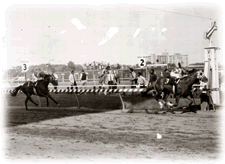
A couple weeks later came the Preakness Stakes at Pimlico in Maryland. By that time, the doubts had been removed, and Secretariat was the 1-5 favorite, despite rival Sham also in the race. The Preakness began the same as the Derby, with Secretariat eventually dropping back to last in the field after coming out of the gate. Going around the first turn, Turcotte thought that their pace was too slow and chirped to his horse. Secretariat reacted with a sudden leap, as if to say, "Hey, I'm ready to go!", and while Big Red and his jockey sped up, the other horses slowed down.

It seemed like the competition was simply loping on the track when the big red horse breezed right past them and took the lead, where he held off Sham and won the Preakness Stakes by two and a half lengths. Pimlico's electric tele-timer had recorded the race at 1:55 for the 1-3/16 mile, a full second slower than the track record. However, the Daily Racing Form had clocked it at 1:53 2/5, a new track record. A Maryland racing official had clocked the race in 1:54 2/5, so Pimlico's officials changed the time of the race to match this figure, saying that this score had been hand-recorded. The time of the race stayed at 1:53 2/5 on the Daily Racing Form's official chart, permanently displaying its disagreement with the time of the 1973 Preakness Stakes.
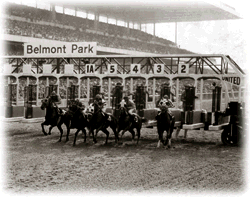
A field of five horses assembled on June 9, 1973, for the last leg of the Triple Crown - the Belmont Stakes, including Secretariat and Sham. The Thoroughbred Times described that day, "What the Belmont Park faithful and a national television audience witnessed was one of the greatest performances in racing history." From the beginning, this race would be altogether different than the Derby and the Preakness. A few moments after breaking out of the gate, Big Red decided to make his own plan and moved up with the leader. Down the backstretch, it simply became a match race between Sham and Secretariat. Mrs. Tweedy feared Sham would finally get his revenge, even though she had great respect for him. However, as the two horses were battling it out on the field, the big red horse started to draw away... and he kept on going. Sham, injuring himself for life, was eventually caught by the other horses and dropped back to last, never to race again. The big chestnut in blue and white checkered silks continued to race with no other competition but himself, widening the gap between he and the others.
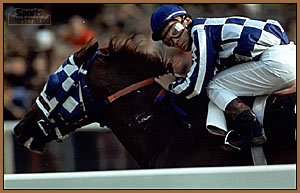
Turcotte Realizes They're All Alone
The sight was breath- taking; announcer Chic Anderson cried over the loudspeaker, "Secretariat is lightening now! He is moving like a tremendous machine!" Not a horse on the field could catch Big Red as he ran solo on the track.
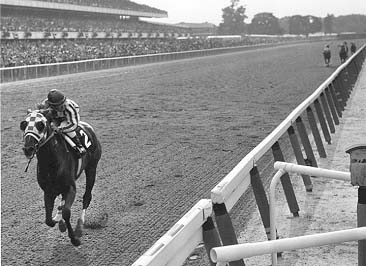
The space between he and the others had grown a full 31 lengths as the flashy chestnut flew past the pole, becoming the ninth horse in history to win the Triple Crown, while smashing a world record for the 1-1/2 mile in 2:24 flat. The time seemed self-destructive; horses were not supposed to be able to run that fast. Even trainer Lucien Laurin thought the tele-timer was broken because of the time that it displayed, saying it was impossible to run that fast. Turcotte, who hadn't even realized they had been that far infront of the others, remarked to him, "He was running easy." In the words of Chic Anderson, "Unbelievable.. an extraordinary performance." Secretariat's amazing twenty-five foot strides had won him the most coveted honor in horse racing, smashing records for the three most important races a horse can ever race in his career; times that have yet to be broken.
During the height of Secretariat's fame, his image graced the covers of magazines and in the newspapers, on the news, and he was presented the Horse of the Year Award for a second time in 1973. Between the Preakness and Belmont, Big Red appeared on the cover of TIME, Newsweek, and Sports Illustrated all in the same week. He raced six more times in his career, including in the Marlboro Cup, when he beat stablemate Riva Ridge (Winner of the 1972 Kentucky Derby and Belmont Stakes). In the Whitney Stakes, Secretariat was bothered by a virus and lost to a horse called Onion. Prove Out managed a sloppy track better than the big red colt in the Woodward Stakes, beating him for the last time. To show how versatile a racer he was, Laurin decided to have Big Red's last two starts on the grass. It was a gloomy, rainy, and foggy day when Secretariat ran his last race at the Canadian International Stakes. Turcotte had to sit out and watch his mount's last race that day, cheering him on from the sidelines. Even then, Big Red won his last race easily. On November 6, 1973, Secretariat officially retired and made his final appearance for all of his adoring fans at the place where it had all began, Aqueduct. Turcotte took him out and warmed him up a bit for the entertainment of the people, and when the horse started to be led off the field, he pulled back. Penny Tweedy recalls, "He fought a bit, like he was saying, 'What's wrong? Aren't I gonna race?!'" Tweedy was sad that his racing career was all over, saying that she wished they could've continued to race him as long as he was winning. Five days later, Secretariat was flown to Claiborne Farm, where he started his new career at stud. He sired a few notable offspring, such as Lady's Secret and Risen Star - one, a Horse of the Year Award winner, and the other a Preakness and Belmont Stakes winner. On Labor Day, 1989, Big Red was diagnosed with laminitis, an inflammation of the hoof. On October 4, 1989, 11:45 a.m. Eastern time, Secretariat was humanely put down at his home at Claiborne Farm to prevent his further suffering. Dead at nineteen, he was buried in the same cemetery as his father at the farm. A biopsy revealed that his heart weighed about twenty-two pounds, greater than any other horse ever examined. (A normal horse's heart weighs in at about eight pounds.) A statue of the great champion was unveiled in Belmont Park as a tribute, with a special statement made in his honor, "Secretariat belongs to history, to the romance of the turf, and to the people." A wreath resembling his silks was placed on the monument in his memory, signifying the passing of a chapter in history.
Secretariat came at a point in time when America needed him the most; it was during the time of Nixon, Watergate, and Vietnam. He was an American original, this big red horse in white and blue silks. The colt was a superhorse who became a national superstar; he won sixteen out of twenty-one of his career starts, losing only five races. His courage and strength gave America the hero it had been seeking, and horse racing an answer to its prayers. People had been waiting a quarter of a century for a horse like Secretariat. His immense power and beauty should never be forgotten, as his victories blaze through our minds and create a dust of memories that will forever be the basis of what other horses will always be judged. He may have been the greatest racehorse that had ever lived, or that there ever will be.
